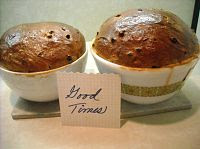Another from the Bixby/Avery vaults.
The Lady Baltimore Cake supposedly originated at the Lady Baltimore Tea Room in Charleston, Virginia. The first documented mention of the cake was in 1906, when the recipe was printed in the the Post Standard of Syracuse, NY. There was also a novel titled Lady Baltimore, written by Owen Wister and released in 1906. [Note that the scanned index card (below) makes mention "Owen Wister's Book (?) - Original]. From that book, here is a passage about a character tasting the cake for the first time:
"I returned to the table and she brought me the cake, and I had my first felicitous meeting with Lady Baltimore. Oh, my goodness! Did you ever taste it? It's all soft, and it's in layers, and it has nuts--but I can't write any more about it; my mouth waters too much.
Delighted surprise caused me once more to speak aloud, and with my mouth full. "But, dear me, this Is delicious!"
Perhaps this was an early example of cross-promotional marketing? The novel being released at the same time the cake becomes popular. If I dig a little deeper, maybe I'll find a Lady Baltimore branded lunch box or action figure.
"LADY BALTIMORE CAKE
Owen Wister's Book - Original
1/2 lb. butter, 1 lb. sugar, 1 lb. flour, 8 eggs (whites only) 4 teaspoon baking powder, 1/2 pt. milk. teaspoon almond flavoring.
(Treatment)
Cream butter and sugar, add milk slowly beat eggs, add flour to butter, sugar and eggs. Stir thoroughly and add teaspoon Essence of Almond. (over)*"
* Bake in two buttered pans 15 -20 minutes, moderate oven.
And, on the reverse of the card, we have the instructions for the FILLING:
"FILLING MATERIAL
3 cups sugar, 4 eggs (whites only) 1/2 gill boiling water*, lemon juice to taste.
(Treatment.)
Pour water over sugar and lemon juice and boil ten minutes. Pour hot syrup thus made over beaten eggs, beat until cool, Flavor with vanilla, add 2 cups chopped walnuts and 2 cups seeded raisins, make whole or in layers. Cover well with icing."
*NOTE: A "GILL" equals four fluid ounces or 1/4 of a US pint. (thanks, kitty!)
The index cards don't specify all the baking details, or the ICING recipe (which is described as a "creamy merengue frosting, flavored with vanilla or sherry." I found a link to a version mentioned by Amy Sedaris in her book "I Like You." (It's also vetted by Martha Stewart, for whatever that's worth to you.) The modern version:
http://www.marthastewart.com/283937/lady-baltimore-cake
(Thanks to 'The Old Foodie' blog for the historical info.)



































